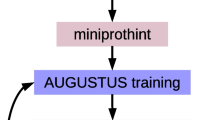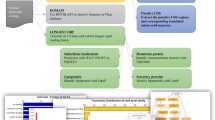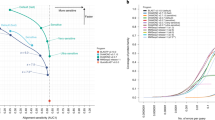Abstract
The argonaute protein (Ago) exists in almost all organisms. In eukaryotes, it functions as a regulatory system for gene expression. In prokaryotes, it is a type of defense system against foreign invasive genomes. The Ago system has been engineered for gene silencing and genome editing and plays an important role in biological studies. With an increasing number of genomes and proteomes of various microbes becoming available, computational tools for identifying and annotating argonaute proteins are urgently needed. We introduce AGONOTES (Argonaute Notes). It is a web service especially designed for identifying and annotating Ago. AGONOTES uses the BLASTP similarity search algorithm to categorize all submitted proteins into three groups: prokaryotic argonaute protein (pAgo), eukaryotic argonaute protein (eAgo), and non-argonaute protein (non-Ago). Argonaute proteins can then be aligned to the corresponding standard set of Ago sequences using the multiple sequence alignment program MUSCLE. All functional domains of Ago can further be curated from the alignment results and visualized easily through Bio::Graphic modules in the BioPerl bundle. Compared with existing tools such as CD-Search and available databases such as UniProt and AGONOTES showed a much better performance on domain annotations, which is fundamental in studying the new Ago. AGONOTES can be freely accessed at http://i.uestc.edu.cn/agonotes/. AGONOTES is a friendly tool for annotating Ago domains from a proteome or a series of protein sequences.





Similar content being viewed by others
Abbreviations
- Ago:
-
Argonaute protein
- AGONOTES:
-
Argonaute Notes
- AaAgo:
-
Aquifex aeolicus argonaute
- eAgo(s):
-
Eukaryotic argonaute protein(s)
- ePIWIs:
-
ePIWI proteins
- hAgo1:
-
Human argonaute 1
- hAgo2:
-
Human argonaute 2
- KpAgo:
-
Kluyveromyces polysporus argonaute
- L1 domain:
-
Linker1 domain
- L2 domain:
-
Linker2 domain
- MID domain:
-
Middle domain
- MpAgo:
-
Marinitoga piezophila argonaute
- mAgo2:
-
Mouse argonaute 2
- non-Ago(s):
-
Non-argonaute protein(s)
- N domain:
-
N-terminal domain
- NgAgo:
-
Natronobacterium gregoryi argonaute
- pAgo(s):
-
Prokaryotic argonaute protein(s)
- PAZ domain:
-
PIWI–Argonaute–Zwille domain
- PIWI domain:
-
P element–induced wimpy testis domain
- PfAgo:
-
Pyrococcus furiosus argonaute
- pPIWIs:
-
pPIWI proteins
- RsAgo:
-
Rhodobacter sphaeroides argonaute
- SpAgo1:
-
Schizosaccharomyces pombe argonaute 1
- TtAgo:
-
Thermus thermophilus argonaute
References
Bohmert K, Camus I, Bellini C, Bouchez D, Caboche M, Benning C (1998) AGO1 defines a novel locus of Arabidopsis controlling leaf development. EMBO J 17(1):170–180. https://doi.org/10.1093/emboj/17.1.170
Makarova KS, Wolf YI, van der Oost J, Koonin EV (2009) Prokaryotic homologs of Argonaute proteins are predicted to function as key components of a novel system of defense against mobile genetic elements. Biol Direct 4:29. https://doi.org/10.1186/1745-6150-4-29
Sheng G, Zhao H, Wang J, Rao Y, Tian W, Swarts DC, van der Oost J, Patel DJ, Wang Y (2014) Structure-based cleavage mechanism of Thermus thermophilus Argonaute DNA guide strand-mediated DNA target cleavage. Proc Natl Acad Sci USA 111(2):652–657. https://doi.org/10.1073/pnas.1321032111
Kaya E, Doxzen KW, Knoll KR, Wilson RC, Strutt SC, Kranzusch PJ, Doudna JA (2016) A bacterial Argonaute with noncanonical guide RNA specificity. Proc Natl Acad Sci USA 113(15):4057–4062. https://doi.org/10.1073/pnas.1524385113
Parker JS, Roe SM, Barford D (2004) Crystal structure of a PIWI protein suggests mechanisms for siRNA recognition and slicer activity. EMBO J 23(24):4727–4737. https://doi.org/10.1038/sj.emboj.7600488
Song JJ, Smith SK, Hannon GJ, Joshua-Tor L (2004) Crystal structure of Argonaute and its implications for RISC slicer activity. Science 305(5689):1434–1437. https://doi.org/10.1126/science.1102514
Swarts DC, Makarova K, Wang Y, Nakanishi K, Ketting RF, Koonin EV, Patel DJ, van der Oost J (2014) The evolutionary journey of Argonaute proteins. Nat Struct Mol Biol 21(9):743–753. https://doi.org/10.1038/nsmb.2879
Olovnikov I, Chan K, Sachidanandam R, Newman DK, Aravin AA (2013) Bacterial argonaute samples the transcriptome to identify foreign DNA. Mol Cell 51(5):594–605. https://doi.org/10.1016/j.molcel.2013.08.014
Swarts DC, Jore MM, Westra ER, Zhu Y, Janssen JH, Snijders AP, Wang Y, Patel DJ, Berenguer J, Brouns SJJ, van der Oost J (2014) DNA-guided DNA interference by a prokaryotic Argonaute. Nature 507(7491):258–261. https://doi.org/10.1038/nature12971
Gao F, Shen XZ, Jiang F, Wu Y, Han C (2016) DNA-guided genome editing using the Natronobacterium gregoryi Argonaute. Nat Biotechnol 34(7):768–773. https://doi.org/10.1038/nbt.3547
Lee SH, Turchiano G, Ata H, Nowsheen S, Romito M, Lou Z, Ryu SM, Ekker SC, Cathomen T, Kim JS (2016) Failure to detect DNA-guided genome editing using Natronobacterium gregoryi Argonaute. Nat Biotechnol 35(1):17–18. https://doi.org/10.1038/nbt.3753
Burgess S, Cheng L, Gu F, Huang J, Huang Z, Lin S, Li J, Li W, Qin W, Sun Y, Songyang Z, Wei W, Wu Q, Wang H, Wang X, Xiong JW, Xi J, Yang H, Zhou B, Zhang B (2016) Questions about NgAgo. Protein Cell 7(12):913–915. https://doi.org/10.1007/s13238-016-0343-9
Qi J, Dong Z, Shi Y, Wang X, Qin Y, Wang Y, Liu D (2016) NgAgo-based fabp11a gene knockdown causes eye developmental defects in zebrafish. Cell Res 26(12):1349–1352. https://doi.org/10.1038/cr.2016.134
Nguyen Q, Iritani A, Ohkita S, Vu BV, Yokoya K, Matsubara A, Ikeda KI, Suzuki N, Nakayashiki H (2018) A fungal Argonaute interferes with RNA interference. Nucleic Acids Res 46(5):2495–2508. https://doi.org/10.1093/nar/gkx1301
Chai G, Yu M, Jiang L, Duan Y, Huang J (2017) HMMCAS: a web tool for the identification and domain annotations of Cas proteins. IEEE/ACM Trans Comput Biol Bioinf. https://doi.org/10.1109/TCBB.2017.2665542
Finn RD, Bateman A, Clements J, Coggill P, Eberhardt RY, Eddy SR, Heger A, Hetherington K, Holm L, Mistry J, Sonnhammer EL, Tate J, Punta M (2014) Pfam: the protein families database. Nucleic acids research 42(Database issue):D222–D230. https://doi.org/10.1093/nar/gkt1223
Chen W, Lv H, Nie F, Lin H (2019) i6 mA-Pred: Identifying DNA N6-methyladenine sites in the rice genome. Bioinformatics. https://doi.org/10.1093/bioinformatics/btz015
Dao FY, Lv H, Wang F, Feng CQ, Ding H, Chen W, Lin H (2018) Identify origin of replication in Saccharomyces cerevisiae using two-step feature selection technique. Bioinformatics. https://doi.org/10.1093/bioinformatics/bty943
He B, Chai G, Duan Y, Yan Z, Qiu L, Zhang H, Liu Z, He Q, Han K, Ru B, Guo FB, Ding H, Lin H, Wang X, Rao N, Zhou P, Huang J (2016) BDB: biopanning data bank. Nucleic Acids Res 44(D1):D1127–1132. https://doi.org/10.1093/nar/gkv1100
He B, Jiang L, Duan Y, Chai G, Fang Y, Kang J, Yu M, Li N, Tang Z, Yao P, Wu P, Derda R, Huang J (2018) Biopanning data bank 2018: hugging next generation phage display. Database J Biolog Databases Curation. https://doi.org/10.1093/database/bay032
He B, Kang J, Ru B, Ding H, Zhou P, Huang J (2016) SABinder: a web service for predicting streptavidin-binding peptides. Biomed Res Int 2016:9175143. https://doi.org/10.1155/2016/9175143
Huang J, Ru B, Zhu P, Nie F, Yang J, Wang X, Dai P, Lin H, Guo FB, Rao N (2012) MimoDB 2.0: a mimotope database and beyond. Nucleic acids research 40(Database issue):D271–D277. https://doi.org/10.1093/nar/gkr922
Kang J, Fang Y, Yao P, Li N, Tang Q, Huang J (2019) NeuroPP: a tool for the prediction of neuropeptide precursors based on optimal sequence composition. Interdiscip Sci 11(1):108–114. https://doi.org/10.1007/s12539-018-0287-2
Li N, Kang J, Jiang L, He B, Lin H, Huang J (2017) PSBinder: a web service for predicting polystyrene surface-binding peptides. Biomed Res Int 2017:5761517. https://doi.org/10.1155/2017/5761517
Ru B, tHoen PA, Nie F, Lin H, Guo FB, Huang J (2014) PhD7Faster: predicting clones propagating faster from the Ph.D.-7 phage display peptide library. J Bioinform Comput Biol 12(1):1450005. https://doi.org/10.1142/s021972001450005x
Tang Q, Nie F, Kang J, Ding H, Zhou P, Huang J (2015) NIEluter: predicting peptides eluted from HLA class I molecules. J Immunol Methods 422:22–27. https://doi.org/10.1016/j.jim.2015.03.021
Xu ZC, Feng PM, Yang H, Qiu WR, Chen W, Lin H (2019) iRNAD: a computational tool for identifying D modification sites in RNA sequence. Bioinformatics. https://doi.org/10.1093/bioinformatics/btz358
Zhang Y, Liu T, Chen L, Yang J, Yin J, Zhang Y, Yun Z, Xu H, Ning L, Guo F, Jiang Y, Lin H, Wang D, Huang Y, Huang J (2019) RIscoper: a tool for RNA–RNA interaction extraction from the literature. Bioinformatics. https://doi.org/10.1093/bioinformatics/btz044
UniProt C (2015) UniProt: a hub for protein information. Nucleic acids research 43(Database issue):D204–D212. https://doi.org/10.1093/nar/gku989
Schultz J, Milpetz F, Bork P, Ponting CP (1998) SMART, a simple modular architecture research tool: identification of signaling domains. Proc Natl Acad Sci USA 95(11):5857–5864
Marchler-Bauer A, Bo Y, Han L, He J, Lanczycki CJ, Lu S, Chitsaz F, Derbyshire MK, Geer RC, Gonzales NR, Gwadz M, Hurwitz DI, Lu F, Marchler GH, Song JS, Thanki N, Wang Z, Yamashita RA, Zhang D, Zheng C, Geer LY, Bryant SH (2017) CDD/SPARCLE: functional classification of proteins via subfamily domain architectures. Nucleic Acids Res 45(D1):D200–D203. https://doi.org/10.1093/nar/gkw1129
Servant F, Bru C, Carrere S, Courcelle E, Gouzy J, Peyruc D, Kahn D (2002) ProDom: automated clustering of homologous domains. Brief Bioinform 3(3):246–251. https://doi.org/10.1093/bib/3.3.246
Swarts DC, Hegge JW, Hinojo I, Shiimori M, Ellis MA, Dumrongkulraksa J, Terns RM, Terns MP, van der Oost J (2015) Argonaute of the archaeon Pyrococcus furiosus is a DNA-guided nuclease that targets cognate DNA. Nucleic Acids Res 43(10):5120–5129. https://doi.org/10.1093/nar/gkv415
Miyoshi T, Ito K, Murakami R, Uchiumi T (2016) Structural basis for the recognition of guide RNA and target DNA heteroduplex by Argonaute. Nat Commun 7:11846. https://doi.org/10.1038/ncomms11846
Yuan YR, Pei Y, Ma JB, Kuryavyi V, Zhadina M, Meister G, Chen HY, Dauter Z, Tuschl T, Patel DJ (2005) Crystal structure of A. aeolicus argonaute, a site-specific DNA-guided endoribonuclease, provides insights into RISC-mediated mRNA cleavage. Mol Cell 19(3):405–419. https://doi.org/10.1016/j.molcel.2005.07.011
Schirle NT, Sheu-Gruttadauria J, MacRae IJ (2014) Structural basis for microRNA targeting. Science 346(6209):608–613. https://doi.org/10.1126/science.1258040
Faehnle CR, Elkayam E, Haase AD, Hannon GJ, Joshua-Tor L (2013) The making of a slicer: activation of human Argonaute-1. Cell Rep 3(6):1901–1909. https://doi.org/10.1016/j.celrep.2013.05.033
Jee D, Yang JS, Park SM, Farmer DT, Wen J, Chou T, Chow A, McManus MT, Kharas MG, Lai EC (2018) Dual strategies for Argonaute2-Mediated biogenesis of erythroid miRNAs underlie conserved requirements for slicing in mammals. Mol Cell 69(2):265–278. https://doi.org/10.1016/j.molcel.2017.12.027
Nakanishi K, Weinberg DE, Bartel DP, Patel DJ (2012) Structure of yeast Argonaute with guide RNA. Nature 486(7403):368–374. https://doi.org/10.1038/nature11211
Wang Y, Geer LY, Chappey C, Kans JA, Bryant SH (2000) Cn3D: sequence and structure views for Entrez. Trends Biochem Sci 25(6):300–302
Mount DW (2007) Using the basic local alignment search tool (BLAST). CSH protocols. https://doi.org/10.1101/pdb.top17
Lemoine F, Correia D, Lefort V, Doppelt-Azeroual O, Mareuil F, Cohen-Boulakia S, Gascuel O (2019) NGPhylogeny.fr: new generation phylogenetic services for non-specialists. Nucleic Acids Res 47(W1):W260–W265. https://doi.org/10.1093/nar/gkz303
Dereeper A, Guignon V, Blanc G, Audic S, Buffet S, Chevenet F, Dufayard JF, Guindon S, Lefort V, Lescot M, Claverie JM, Gascuel O (2008) Phylogeny.fr: robust phylogenetic analysis for the non-specialist. Nucleic Acids Res 36(Web Server issue):W465–W469. https://doi.org/10.1093/nar/gkn180
Wu Z, Tan S, Xu L, Gao L, Zhu H, Ma C, Liang X (2017) NgAgo-gDNA system efficiently suppresses hepatitis B virus replication through accelerating decay of pregenomic RNA. Antiviral Res 145:20–23. https://doi.org/10.1016/j.antiviral.2017.07.005
Wei Q, Liao J, Yu X, Wang EJ, Wang C, Luu HH, Haydon RC, Lee MJ, He TC (2016) An NgAgo tool for genome editing: did CRISPR/Cas9 just find a competitor? Genes Dis 3(3):169–170. https://doi.org/10.1016/j.gendis.2016.06.001
Khin NC, Lowe JL, Jensen LM, Burgio G (2017) No evidence for genome editing in mouse zygotes and HEK293T human cell line using the DNA-guided Natronobacterium gregoryi Argonaute (NgAgo). PLoS One 12(6):e0178768. https://doi.org/10.1371/journal.pone.0178768
Edgar RC (2004) MUSCLE: multiple sequence alignment with high accuracy and high throughput. Nucleic Acids Res 32(5):1792–1797. https://doi.org/10.1093/nar/gkh340
Acknowledgements
The authors are grateful to the anonymous reviewers for their valuable suggestions and comments, which have led to the improvement of this paper. In addition, thanks to Hui Yang for valuable discussions and suggestions. This work was supported by the National Natural Science Foundation of China [Grant no. 61571095] and the China Postdoctoral Science Foundation Grant [Grant no. 2019M653369].
Author information
Authors and Affiliations
Corresponding author
Ethics declarations
Conflict of Interest
The authors declare no conflict of interest, financial or otherwise.
Human and Animal Rights
No animals/humans were used for studies that are the basis of this research.
Rights and permissions
About this article
Cite this article
Jiang, L., Yu, M., Zhou, Y. et al. AGONOTES: A Robot Annotator for Argonaute Proteins. Interdiscip Sci Comput Life Sci 12, 109–116 (2020). https://doi.org/10.1007/s12539-019-00349-4
Received:
Revised:
Accepted:
Published:
Issue Date:
DOI: https://doi.org/10.1007/s12539-019-00349-4




